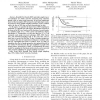Free Online Productivity Tools
i2Speak
i2Symbol
i2OCR
iTex2Img
iWeb2Print
iWeb2Shot
i2Type
iPdf2Split
iPdf2Merge
i2Bopomofo
i2Arabic
i2Style
i2Image
i2PDF
iLatex2Rtf
Sci2ools
CORR
2010
Springer
2010
Springer
On the bias of BFS
Abstract--Breadth First Search (BFS) and other graph traversal techniques are widely used for measuring large unknown graphs, such as online social networks. It has been empirically observed that incomplete BFS is biased toward high degree nodes. In contrast to more studied sampling techniques, such as random walks, the bias of BFS has not been characterized to date. In this paper, we quantify the degree bias of BFS sampling. In particular, we calculate the node degree distribution expected to be observed by BFS as a function of the fraction of covered nodes, in a random graph RG(pk) with a given (and arbitrary) degree distribution pk. Furthermore, we also show that, for RG(pk), all commonly used graph traversal techniques (BFS, DFS, Forest Fire, and Snowball Sampling) lead to the same bias, and we show how to correct for this bias. To give a broader perspective, we compare this class of exploration techniques to random walks that are well-studied and easier to analyze. Next, we study ...
| Added | 09 Dec 2010 |
| Updated | 09 Dec 2010 |
| Type | Journal |
| Year | 2010 |
| Where | CORR |
| Authors | Maciej Kurant, Athina Markopoulou, Patrick Thiran |
Comments (0)

